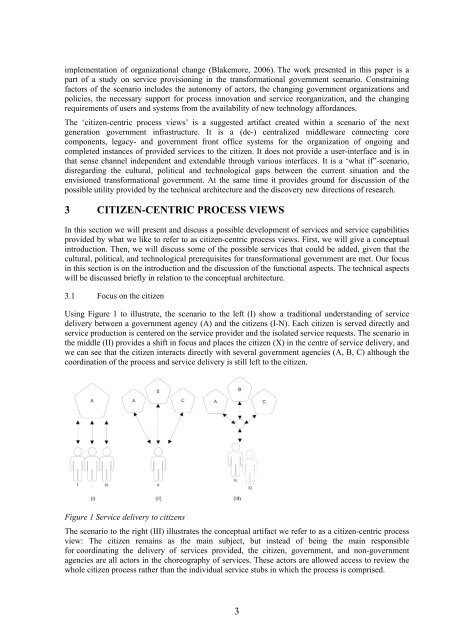Multi-channel provisioning of public services - Department of ...
Multi-channel provisioning of public services - Department of ...
Multi-channel provisioning of public services - Department of ...
Create successful ePaper yourself
Turn your PDF publications into a flip-book with our unique Google optimized e-Paper software.
implementation <strong>of</strong> organizational change (Blakemore, 2006). The work presented in this paper is a<br />
part <strong>of</strong> a study on service <strong>provisioning</strong> in the transformational government scenario. Constraining<br />
factors <strong>of</strong> the scenario includes the autonomy <strong>of</strong> actors, the changing government organizations and<br />
policies, the necessary support for process innovation and service reorganization, and the changing<br />
requirements <strong>of</strong> users and systems from the availability <strong>of</strong> new technology affordances.<br />
The ‘citizen-centric process views’ is a suggested artifact created within a scenario <strong>of</strong> the next<br />
generation government infrastructure. It is a (de-) centralized middleware connecting core<br />
components, legacy- and government front <strong>of</strong>fice systems for the organization <strong>of</strong> ongoing and<br />
completed instances <strong>of</strong> provided <strong>services</strong> to the citizen. It does not provide a user-interface and is in<br />
that sense <strong>channel</strong> independent and extendable through various interfaces. It is a ‘what if”-scenario,<br />
disregarding the cultural, political and technological gaps between the current situation and the<br />
envisioned transformational government. At the same time it provides ground for discussion <strong>of</strong> the<br />
possible utility provided by the technical architecture and the discovery new directions <strong>of</strong> research.<br />
3 CITIZEN-CENTRIC PROCESS VIEWS<br />
In this section we will present and discuss a possible development <strong>of</strong> <strong>services</strong> and service capabilities<br />
provided by what we like to refer to as citizen-centric process views. First, we will give a conceptual<br />
introduction. Then, we will discuss some <strong>of</strong> the possible <strong>services</strong> that could be added, given that the<br />
cultural, political, and technological prerequisites for transformational government are met. Our focus<br />
in this section is on the introduction and the discussion <strong>of</strong> the functional aspects. The technical aspects<br />
will be discussed briefly in relation to the conceptual architecture.<br />
3.1 Focus on the citizen<br />
Using Figure 1 to illustrate, the scenario to the left (I) show a traditional understanding <strong>of</strong> service<br />
delivery between a government agency (A) and the citizens (I-N). Each citizen is served directly and<br />
service production is centered on the service provider and the isolated service requests. The scenario in<br />
the middle (II) provides a shift in focus and places the citizen (X) in the centre <strong>of</strong> service delivery, and<br />
we can see that the citizen interacts directly with several government agencies (A, B, C) although the<br />
coordination <strong>of</strong> the process and service delivery is still left to the citizen.<br />
Figure 1 Service delivery to citizens<br />
The scenario to the right (III) illustrates the conceptual artifact we refer to as a citizen-centric process<br />
view: The citizen remains as the main subject, but instead <strong>of</strong> being the main responsible<br />
for coordinating the delivery <strong>of</strong> <strong>services</strong> provided, the citizen, government, and non-government<br />
agencies are all actors in the choreography <strong>of</strong> <strong>services</strong>. These actors are allowed access to review the<br />
whole citizen process rather than the individual service stubs in which the process is comprised.<br />
3
















